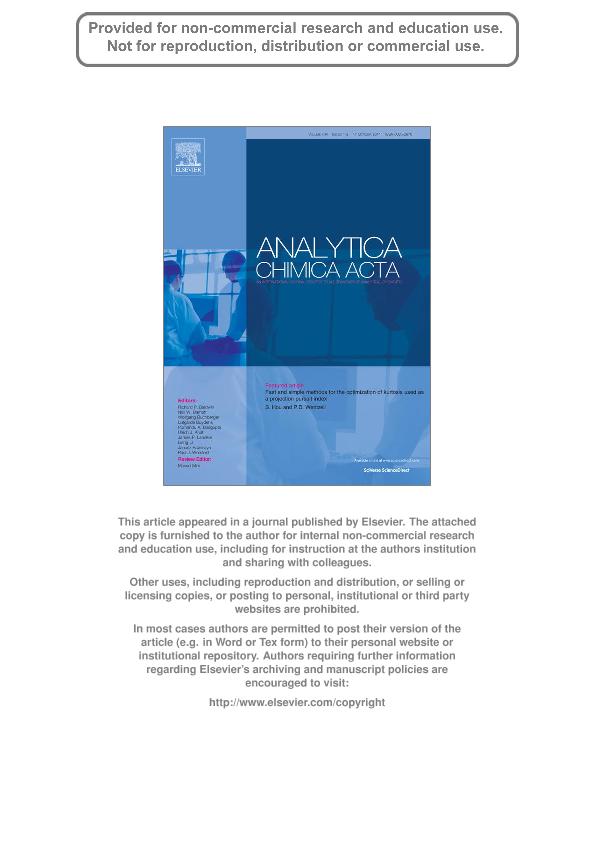Mostrar el registro sencillo del ítem
dc.contributor.author
Langmaier, Jan
dc.contributor.author
Garay, Fernando Sebastian

dc.contributor.author
Kivlehan, Francine
dc.contributor.author
Chaum, Edward
dc.contributor.author
Lindner, Erno
dc.date.available
2018-10-03T19:10:15Z
dc.date.issued
2011-10
dc.identifier.citation
Langmaier, Jan; Garay, Fernando Sebastian; Kivlehan, Francine; Chaum, Edward; Lindner, Erno; Electrochemical quantification of 2,6-diisopropylphenol (propofol); Elsevier Science; Analytica Chimica Acta; 704; 1-2; 10-2011; 63-67
dc.identifier.issn
0003-2670
dc.identifier.uri
http://hdl.handle.net/11336/61593
dc.description.abstract
2,6-Diisopropylphenol (propofol) is a potent anesthetic drug with fast onset of the anesthetic effect and short recovery time for the patients. Outside of the United States, propofol is widely used in performing target controlled infusion anesthesia. With the long term vision of an electrochemical sensor for in vivo monitoring and feedback controlled dosing of propofol in blood, different alternatives for the electrochemical quantification of propofol using diverse working electrodes and experimental conditions are presented in this contribution.When the electrochemical oxidation of propofol takes place on a glassy carbon working electrode, an electrochemically active film grows on the electrode surface. The reduction current of the film is proportional to the propofol concentration and the accumulation time. Based on these findings a stripping analytical method was developed for the detection of propofol in acidic solutions between 0 and 30 μM, with a detection limit of 5.5 ± 0.4 μM.By restricting the scanned potential window between 0.5. V and 1.0. V in cyclic voltammetric experiments, the formation of the electrochemically active polymer can be prevented. This allowed the development of a direct voltammetric method for assessing propofol in acidic solutions between 0 and 30 μM, with a 3.2 ± 0.1 μM (n= 3) detection limit.The stripping method has a better sensitivity but somewhat worse reproducibility because the electrode surface has to be renewed between each experiment. The direct method does not require the renewal of the electrode surface between measurements but has no adequate selectivity towards the common interfering compounds. © 2011 Elsevier B.V.
dc.format
application/pdf
dc.language.iso
eng
dc.publisher
Elsevier Science

dc.rights
info:eu-repo/semantics/openAccess
dc.rights.uri
https://creativecommons.org/licenses/by-nc-sa/2.5/ar/
dc.subject
2,6-Diisopropylphenol
dc.subject
Anesthesia
dc.subject
Cyclic Voltammetry
dc.subject
Electrochemistry
dc.subject
Propofol
dc.subject
Target-Controlled Infusion Anesthesia
dc.subject.classification
Otras Ciencias Químicas

dc.subject.classification
Ciencias Químicas

dc.subject.classification
CIENCIAS NATURALES Y EXACTAS

dc.title
Electrochemical quantification of 2,6-diisopropylphenol (propofol)
dc.type
info:eu-repo/semantics/article
dc.type
info:ar-repo/semantics/artículo
dc.type
info:eu-repo/semantics/publishedVersion
dc.date.updated
2018-10-01T15:23:16Z
dc.journal.volume
704
dc.journal.number
1-2
dc.journal.pagination
63-67
dc.journal.pais
Países Bajos

dc.journal.ciudad
Amsterdam
dc.description.fil
Fil: Langmaier, Jan. University of Memphis; Estados Unidos. Academy of Sciences of the Czech Republic; República Checa
dc.description.fil
Fil: Garay, Fernando Sebastian. Consejo Nacional de Investigaciones Científicas y Técnicas. Centro Científico Tecnológico Conicet - Córdoba. Instituto de Investigaciones en Físico-química de Córdoba. Universidad Nacional de Córdoba. Facultad de Ciencias Químicas. Instituto de Investigaciones en Físico-química de Córdoba; Argentina. University of Memphis; Estados Unidos
dc.description.fil
Fil: Kivlehan, Francine. University of Memphis; Estados Unidos
dc.description.fil
Fil: Chaum, Edward. University of Tennessee; Estados Unidos
dc.description.fil
Fil: Lindner, Erno. University of Memphis; Estados Unidos
dc.journal.title
Analytica Chimica Acta

dc.relation.alternativeid
info:eu-repo/semantics/altIdentifier/doi/https://dx.doi.org/10.1016/j.aca.2011.08.003
dc.relation.alternativeid
info:eu-repo/semantics/altIdentifier/url/https://www.sciencedirect.com/science/article/pii/S0003267011010774
Archivos asociados
